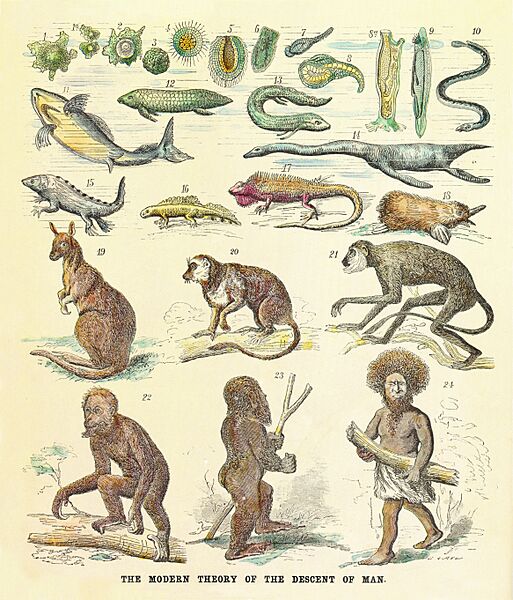Archivo: Human pedigree

Descripción: G Avery's opinion of The modern theory of the descent of man, by Ernst Haeckel, published in Anthropogenie oder Entwicklungsgeschichte des Menschen (The Evolution of Man),1874. The figure show the human pedigree as a Great Chain of Being, illustrated by modern and fossil species. Hand-coloured print Legend: 1 Amoeba 1a Asexual reproduction (amoeba dividing) 2 Sexual reproduction (cell with spore) 3 Multi-cellular organism (early embryonic stage) 4 Muliticellular organism with three germ layers (blastula) 5 Organism with primitive mouth (gastrula) 6 Planaria 7 Worm (leech) 8 Primitive chordate (tunicate larva) 8a Adult tunicate 9 Lancelet 10 Jawless fish (lamprey) 11 Cartilaginous fishes (shark) 12 Australian lungfish 13 South American lungfish 14 Aquatic reptile (plesiosaur) 15 Aquatic amphibian (Axolotl) 16 Modern amphibian (newt) 17 Reptile (iguana) 18 Monotreme (platypus) 19 Marsupial (kangaroo) 20 Prosimian (lemur) 21 Monkey (langur) 22 Ape (orangutan) 23 Ape-man (Pithecanthropus) 24 Modern human (a Papuan)
Título: Human pedigree
Créditos: Scientific American Note: In the online edition of Scientific American, March 11, 1876, p. 167 Scientific American the image appears only in black and white. Proof of a colored version is not possible there. Alternatively, reference can be made to the reviewed publication Ernst Haeckel, Nikolai Miklucho-Maclay and the racial controversy over the Papuans in Frontiers in Zoology, in which the colored version is shown under Fig. 16.
Autor(a): G Avery
Términos de Uso: Dominio Público
Licencia: Dominio Público
¿Se exige la atribución?: No
Usos del archivo
El siguiente archivo es un duplicado de éste (más detalles):
La siguiente página enlaza a este archivo:

